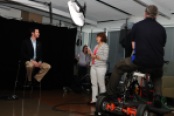We recently developed an inspiring conference video for the nonprofit JPro, the organization of, by, and for all those who work at Jewish organizations across the United States and Canada. It’s a hard-working group! In addition to year-round programming, every three years JPro runs a conference that gathers Jewish community professionals to share ideas, network and learn. This year, after two years of prolific change, the conference, JPro22: Going Places, Together in partnership with the Jewish Federations of North America, was looking for a fresh approach to its annual Young Professional Award video. The goal was to weave together all six stories of the award winners into one big story arc telling how, through their dedicated work, these emerging leaders evoke the bigger themes of JPro and its community of nonprofit professionals. So we dug into our ideas bag and many meetings and weeks later, turned out the video at the end of this post.
Setting the Goals
We first took a look at the project’s goals and opportunities. Right away, we knew the awardees were young, active professionals, so we wanted to create a look that matched their energy. We decided to create an animated visual approach with angles and colors that keyed off of the wonderful conference logo designed by Greater Good Strategy. With its bright colors and lines which cleverly incorporate a Jewish six-pointed star, this logo inspired our thinking. We wanted to evoke the intersectionality of JPro community’s work and Jewish values, while baking the colors of the event logo into our visual framework. And by the way, we love it when clients have a brand guide with RGB values for video!
Solving Problems Before They Happen
In pre-production, we always assess our challenges and come up with solutions. One key challenge for this project was being able to deliver for a big screen at a conference while working with a wide range of UGC (user-generated content) from each of the awardees—in a wide range of resolutions, formats and sizes. Within our timeframe, we couldn’t possibly shoot our usual 4K b-roll in six locations to demonstrate the important work of these awardees and their organizations, so we knew we would be relying on existing assets like photographs and video to tell their stories. By designing an animated framing device, with a gentle color wash evoking key colors of the logo, we could highlight the best portions of these images. And by not blowing the images up too much, we could avoid pixilation on a big screen at the conference. Our goal is always to think multi-platform, so big screen impact was critical for this project, while retaining a design that could work online after the event.

Using an animated framing device helped to draw the eye to the best storytelling parts of visual assets.
Remote Interview Workflow
Since the fabulous JPro awardees work in multiple cities across North America, some in Canada still in lock-down, we quickly dispensed with the idea of travelling to shoot interviews or shipping 4K cameras to them, and decided on a simpler remote interview workflow. We used Zoom to pre-interview each awardee, to delve into their individual story arcs and themes. I always get pre-interviews transcribed with Rev.com so I can review them, note key phrases or stories, and start building out my interview questions and story arc. What’s cool about Rev is you can also scrub through the video and see how those selections look on camera. Then we scheduled the actual interview recordings. Rather than relying on Zoom, we used a studio Tricaster system with engineer. The Tricaster can work with signals coming via Zoom or Skype, and stabilizes the incoming VOIP signal. The engineer isolates just the interviewee, using all available video resolution for their recording and not wasting it recording the other people on the call. And in this case, our favorite studio also has last-mile fiber optic cable, keeping our signal as pristine as possible.

A little BTS of my home setup for on our remote interviewee, lower left, and our editor/co-producer Danilda Martinez, lower right. (Interface Media Group Engineer Monte Cansler is hiding!) Note my hi-res Blackmagic Pocket Cinema Pro camera is off, since I’m not being recorded.
Post Workflow
Once remote interviews were recorded, we immediately got them transcribed so I could start curating soundbites and developing and editing script based on the themes that would drive each video segment. The goal was to develop a key theme for each awardee that would flow seamlessly into the next theme and awardee, but also tell a bigger, unified story about JPro. The themes were then incorporated into the After Effects graphics framework for the video. Once I selected soundbites, we built a “radio edit” (voices only, no pictures) to be sure the story arc worked before our talented producer/editor Danilda Martinez began selecting associated visuals for the Premier Pro timeline. Throughout the editing process, we got alignment on visuals, soundbites and themes from our client using Wipster.io to manage comments and ensure any proposed revisions got addressed quickly with our post team.
Moving from Premiere to After Effects, our animation designer Chris DiNardo placed each video frame into a series of customized motion templates to adjust and crop images and create angled transitions that matched angles and lines in the event logo. We even brought this visual theme into the lower thirds (on screen names and titles of speakers) for continuity of design. Throughout our post-production process, I kept revising the script so that our team always had an “on paper” representation of what was going on in the edit.

Keeping a unified brand look throughout–including “lower thirds” where we ID people on screen–is another key to good video storytelling.
Telling great impact stories is my passion and that of every member of our team. The JPro22 Young Professional Award video project exemplifies how we use creativity and technology to support nonprofit organizations, their partners, funders and stakeholders through the power of video storytelling.









